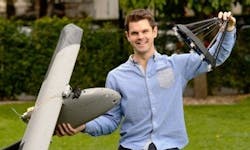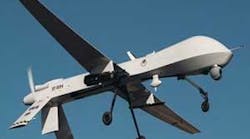Infrared cameras and LEDs allow in-flight UAV refueling
University of Sydney researcher Daniel Wilson has designed and successfully tested a method using infrared vision and light-emitting diodes (LEDs) for autonomously docking drones for refueling in mid-air. Wilson, whose PhD research addressed the limited endurance levels of unmanned aerial vehicles (UAVs) says, "At the moment, a UAV's range and endurance is constrained by the amount of fuel that can be stored on board. As you add more fuel, the weight of the aircraft increases, which means more fuel must be consumed to stay aloft."
Working at the University's Australian Centre for Field Robotics and Marulan air strip, Wilson used a combination of precise measurements from an infrared camera, with GPS and inertial sensors, to allow the sky-high docking to occur.
Related Article
"Aerial refuelling has been used with manned aircraft, but to the best of our knowledge, UAV airborne docking had not been demonstrated prior until our experiments late last year. The biggest challenge is the highly accurate and reliable relative positioning performance to allow a second aircraft to dock with a small target, in the air, and amidst turbulence," says Wilson.
As part of his ongoing efforts to meet the engineering challenges, Wilson developed an autopilot and rapid software development process which twice won him the International Simulink Design Challenge. Now successfully tested he explains the principle behind his airborne docking design:
"There are two autonomous aircraft, a leader and a follower. The leader tows a cone-shaped, parachute-like drogue. The objective is for the follower to autonomously dock its nose, within the drogue. Initially both the aircraft rendezvous to a formation position where the follower's infrared camera can observe infrared LED markers on the leader's wingtips and tail. Once docked, the follower is commanded to station for a certain amount of time to simulate refuelling or recharging. The follower disconnects and resumes its mission," says Wilson.
"In addition to docking, this system could be used for any application that requires highly accurate positioning, relative to a static or moving target. This could include, precision landing on ships, net recovery or close formation flight," says Wilson.
The complete results of Wilson’s four-year research project co-supervised by professor Salah Sukkarieh and Ali Goktogan will be described in his PhD thesis "Guidance, Navigation and Control for UAV Close Formation Flight and Airborne Docking" scheduled for publication later this year. His recent airborne docking flight test results can be viewed on YouTube.
SOURCE: The University of Sydney; http://sydney.edu.au/news/84.html?newsstoryid=14848
About the Author

Gail Overton
Senior Editor (2004-2020)
Gail has more than 30 years of engineering, marketing, product management, and editorial experience in the photonics and optical communications industry. Before joining the staff at Laser Focus World in 2004, she held many product management and product marketing roles in the fiber-optics industry, most notably at Hughes (El Segundo, CA), GTE Labs (Waltham, MA), Corning (Corning, NY), Photon Kinetics (Beaverton, OR), and Newport Corporation (Irvine, CA). During her marketing career, Gail published articles in WDM Solutions and Sensors magazine and traveled internationally to conduct product and sales training. Gail received her BS degree in physics, with an emphasis in optics, from San Diego State University in San Diego, CA in May 1986.

